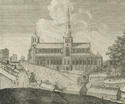 The earliest fuels used in what is now Glasgow would have been wood and peat. That there were extensive forests in the prehistoric Clyde valley is suggested by the survival of the remains of crannogs (artificial islands made mainly of timber) and of dugout canoes made from the trunks of large trees. Peat must have been available in low-lying areas such as Mall's Mire, near Polmadie. The early settlers would have relied on human and animal power, but there may have been small watermills with horizontal waterwheels in the vicinity of the Cathedral.
The earliest fuels used in what is now Glasgow would have been wood and peat. That there were extensive forests in the prehistoric Clyde valley is suggested by the survival of the remains of crannogs (artificial islands made mainly of timber) and of dugout canoes made from the trunks of large trees. Peat must have been available in low-lying areas such as Mall's Mire, near Polmadie. The early settlers would have relied on human and animal power, but there may have been small watermills with horizontal waterwheels in the vicinity of the Cathedral.
 The earliest definite use of power was for grinding corn in mills with vertical waterwheels on the Molendinar and probably on the Kelvin and the White Cart. Such mills were part of the feudal system brought into Scotland in the 11th century and the first Glasgow mills probably followed soon after.
The earliest definite use of power was for grinding corn in mills with vertical waterwheels on the Molendinar and probably on the Kelvin and the White Cart. Such mills were part of the feudal system brought into Scotland in the 11th century and the first Glasgow mills probably followed soon after.
 In the late mediaeval and early modern period coal began to be used as a fuel as coal seams outcropped in the East and West ends and were initially easy to work. By 1560 the water-power of the Molendinar was inadequate to satisfy the needs of the city for meal and flour, and there was already a mill on the Kelvin near Partick. Cardonald, Cathcart, Crookston and Langside mills were probably in being by that time. As far as we know, corn and malt milling were the only industries using power in the Glasgow area before 1560.
In the late mediaeval and early modern period coal began to be used as a fuel as coal seams outcropped in the East and West ends and were initially easy to work. By 1560 the water-power of the Molendinar was inadequate to satisfy the needs of the city for meal and flour, and there was already a mill on the Kelvin near Partick. Cardonald, Cathcart, Crookston and Langside mills were probably in being by that time. As far as we know, corn and malt milling were the only industries using power in the Glasgow area before 1560.